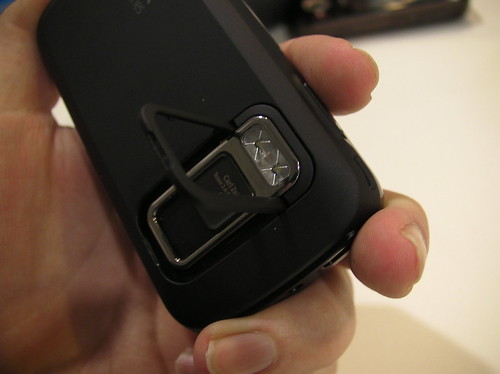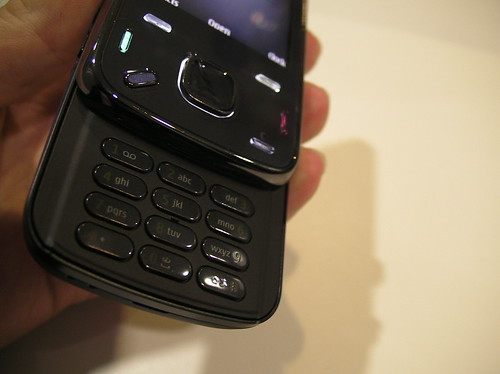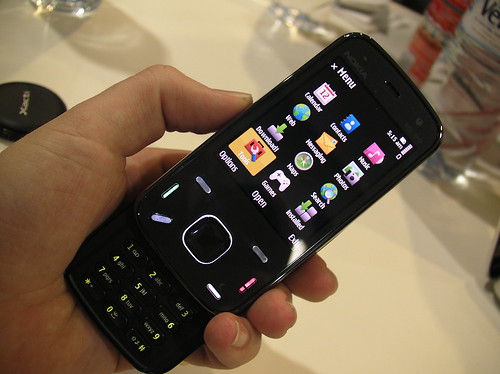Eagle eyes at the Mobile World Congress spotted that the N86 demo units had some interesting name labels on them, specifically that they were N85 8MP units (I think Mobile Industry Review blogged it first). The plan seems to have been to do a similar update that the N95 8GB was over the original N85, and when you take a closer look at the specs, there's only a handful of differences beyond the updated camera. Let's have a closer look.

Side by side, the N85 and the N86 8MP
Physical Dimensions
| Nokia N85 |
Nokia N86 8MP |
|
| Size | 103 x 50 x 16 mm |
103.4 x 51.4 x 16.5-18.5 mm |
| Weight and Vol |
128g and 76cc |
149g and 84cc |
| Display |
2.6" OLED Screen |
2.6" OLED Screen |
| Format | Two way slider with spring assist |
Two way slider with spring assist |
| Additional | - | Kick stand |
Apart from a little bit of a middle aged spread, the N86 retains as much of the svelte dimensions from the N85 as possible. You have to assume the extra size is to allow for the increased volume of the camera optics, which will also cause the impact on the weight. Interesting to see that the N96 contributes just one feature here - the kick stand to make it easier to watch video on the phone.

Firmware and Selected Functionality
|
|
Nokia N85 |
Nokia N86 8MP |
| Symbian Version |
9.3 |
9.3 |
| S60 Version |
S60v3 Feature Pack 2 |
S60v3 Feature Pack 2 |
| Firmware updates |
Yes, available via PC Suite or Over the Air |
Yes, available via PC Suite or Over the Air |
| GPS |
GPS and A-GPS |
GPS and A-GPS |
No differences here, with the over the air firmware updates available on both devices. Previously you were required to use a PC to get new firmwares on your phone. Now with over the air available, coupled with the recent technical changes so that user data is preserved during a firmware upgrade, this de-couples the N86 from requiring a PC connection to be an efffective device, making the PC totally optional. Good news for Mac fans; and the emerging legions of users in Asia who don't have easy access to desktop technology.
Keys and Input
|
|
Nokia N85 |
Nokia N86 8MP |
| Numeric Keypad |
Yes, on a single plastic sheet. |
Yes, as seperate physical keys. |
| Cover Keys |
S60, Menu, Multimedia, Send/End, NaviWheel |
S60, Menu, Send/End, NaviWheel |
| Side Keys |
Volume, camera, key lock |
Volume, camera, key lock |
| Top Keys |
4 dedicated media, zoom and gaming keys |
4 dedicated media, zoom and gaming keys |
| Additional | - | Kick stand |
Nice to see that the single sheet of plastic with raised lines to guide you to where number keys are has been replaced with 12 seperate buttons, one for each numeric key. This is a good change in the physical UI and should help people feel comfortable with the N86 over the N85.
One other major change here to note, and that's the rationalisation of the keys on the front of the device, with the loss of the multimedia key. This could cause a touch of confusion putting the devices side by side, as the clear and s60 buttons on the N85 were areas on the plastic, but are now physical buttons, making the N86 appear to carry more buttons than the N85 when the key backlights are off.

Power and Battery
|
|
Nokia N85 |
Nokia N86 8MP |
| Capacity |
BL-5K 1200mAh Li-ON |
BL-5K 1200 mAh Li-ON |
| Talk Time (up to...) |
6.9 hours (GSM), 4.5 hours (WCDMA) |
6.3 hours (GSM), 3.9 hours (WCDMA) |
| Standby Time (up to...) |
363 hours (GSM), 363 hours (WCDMA) | 315 hours (GSM), 275 hours (WCDMA) |
A slight drop in life on the N86, and I suspect this is down to the base configurations of the respective devices, rated for 8GB microSD cards on the N85 and 16GB on the N86. Power management is a black art, and with the N86 still some time away from the shops, the firmware may get an upgrade to increase that GSM talk time by 35 minutes, to bring it back on par.
Imaging and Video Recording
| Nokia N85 |
Nokia N86 8MP |
|
| Storage | 74MB dynamic RAM , microSD (officially to 8GB) |
74MB dynamic RAM, 8GB internal, microSD (officially to 16GB) |
| Camera |
5 megapixel (2584x1938) |
8 megapixel (3280x2464) |
| Focal Length |
5.45 mm |
4.61 mm |
| Flash | Dual LED |
Dual LED |
| Variable Aperture | No | Yes (F2.4, F3.2, F4.8) |
| Video (rear camera) |
VGA (640x480) at 30 fps |
VGA (640x480) at 30 fps |
| Video (front camera) | 352x288 at 15fps |
352x288 at 15fps |
| TV Out |
Yes, via Nokia cable | Yes, via Nokia cable |
It should be no surprise that changes have been made to the imaging on the N86 as this is the main selling point. Increasing the CMOS sensor to cope with 8 megapixels is only part of the story (but the easiest for people to understand). I know that Steve was more excited about the addition of variable aperture to the N86 than anything else. Care to jump in here Steve? [Yes, the new optics and - I suspect - physically larger sensor should provide far, far better performance in non-sunlit conditions, rivalling standalone cameras - Ed]
While the raw specs of the video recording are identical, I'm expecting the N86 to have a better picture and vividness in video, purely down to the physical changes in the optics. I just wish, with all the online web services that allow people to webcam themselves on the web (e.g. 12 seconds or Seesmic) that the front camera was beefed up to QVGA and 30fps at a minimum.

Music and Audio
| Nokia N85 |
Nokia N86 8MP |
|
| UPnP | Yes |
Yes |
| FM Radio |
87.5 - 108 MHz with RDS |
87.5 - 108 MHz with RDS |
| FM Transmitter |
88.1 - 107.9 MHz |
88.1 - 107.9 MHz |
| 3.5mm Stereo jack | Yes |
Yes |
| Music Store support | Yes | Yes |
| Podcast support |
Yes |
Yes |
| Stereo speakers | Yes |
Yes |
No real surprises here - the additon of FM Transmitter support was the N85's new feature, and Nokia's Music Suite is pretty mature on the handset, so the N86 carrying everything over would be expected. And we're still in the situation where the inclusion of a 3.5mm headphone jack is a surprising feature and needs promoting.

Summary
Once you put the stats together like this and see just how similar the two devices are, it's very obvious that the N86 8MP was derived from the N85, just like the N95 and N95 8GB are close cousins. It's interesting that a marketing and sales message has taken over an ordered line of succession, probably to keep the N85 in the retail channel as long as possible as the 'regular' device. I think this is actually a good call to make, partly because the N86 8MP is not going to be in the shops tomorrow and the renumbering won't depress sales of the N85. Having a wide range of devices at differing price points means that customers should always be able to find one that fits their budget in Nokia's line-up.
For more specs, visit Nokia's page for the N85 and N86 8MP respectively.
-- Ewan Spence, Feb 2009.
Rafe's viewpoint
What Ewan says about the specifications is absolutely correct, the camera is the only significant difference, but, in my opinion, the story is not that simple. Leaving aside the camera and flash issue, which I'll address in some forthcoming commentary, the styling and design details, materials used in the device and the overall build quality add up to a significant difference.
The N86's styling fits in with the Nseries design language for 2009 (the only other member of this family currently is the N97). This is most notable in the design of the keys and the control cluster (angled home key, no multimedia key, improved spacing). In contrast to the N85, the N86 makes greater use of metallic material on the outside of the device (the metallic frame is on the outside of the device - similar to the E71). One of the consequences of this material choice is an improved build quality and, subjectively, a greater feel of solidity in the hand. There are a number of other touches too. For example, the N86's softkeys have haptic feedback, which when combined together with the raised ridge, make a significant improvement over the flat light-up keys of the N85.
Nor should the software tweaks be under-estimated. The addition of a panorama mode and support for all the latest Ovi services add value (yes these can be added to the N85, but that's the domain of firmware updates or side loading of software).
I think it is also important to understand that the days of a single smartphone based on unique hardware are gone. Today we see entire families of devices, all with a common hardware platform. The N78, N79, E71, E66, 5320, 6220 and more are all essentially based on the same hardware platform. Clearly there's more variation across these phones than the N85 and N86 8MP, but in some cases the difference, in pure specifications terms, is not as large as you may realise. It is also important to recognise that style, and other subjective criteria, such as the feel in the hand, colour or material choice, are more important to many consumers than hardware specifications. With smartphones being driven by both software and hardware platforms, specifications are really only an increasingly small portion of the overall product experience.
I can only underline Ewan's point that device numbering is heavily influenced by the positioning and marketing story of a device. This isn't anything new - it's just a bit more obvious with the N86 8MP. Given the attention that Nokia is paying to both the camera integration and the design story, I think the N86 does more to justify a separate designation than some of the earlier product evolutions we have seen in Nokia's S60 ranges.
Ultimately, there's one difference that will, at least for some consumers, make more of a difference than anything else discussed above. Price. The 'press release price', before taxes and subsidies, for the N85 was 450 Euro, for the N86 8MP it is 375 Euro. That's a difference of 75 EURO (around 16%) which is significant given a gap of less than 8 months and the inclusion of a significantly improved camera and 8GB of memory... and that's without considering the design improvements.
As a result of the differences discussed above, I expect the N86 8MP may well have a greater appeal to those looking to upgrade from the N95 (all variants) than the N85 did.
Rafe Blandford, AAS, 23 Feb 2009
